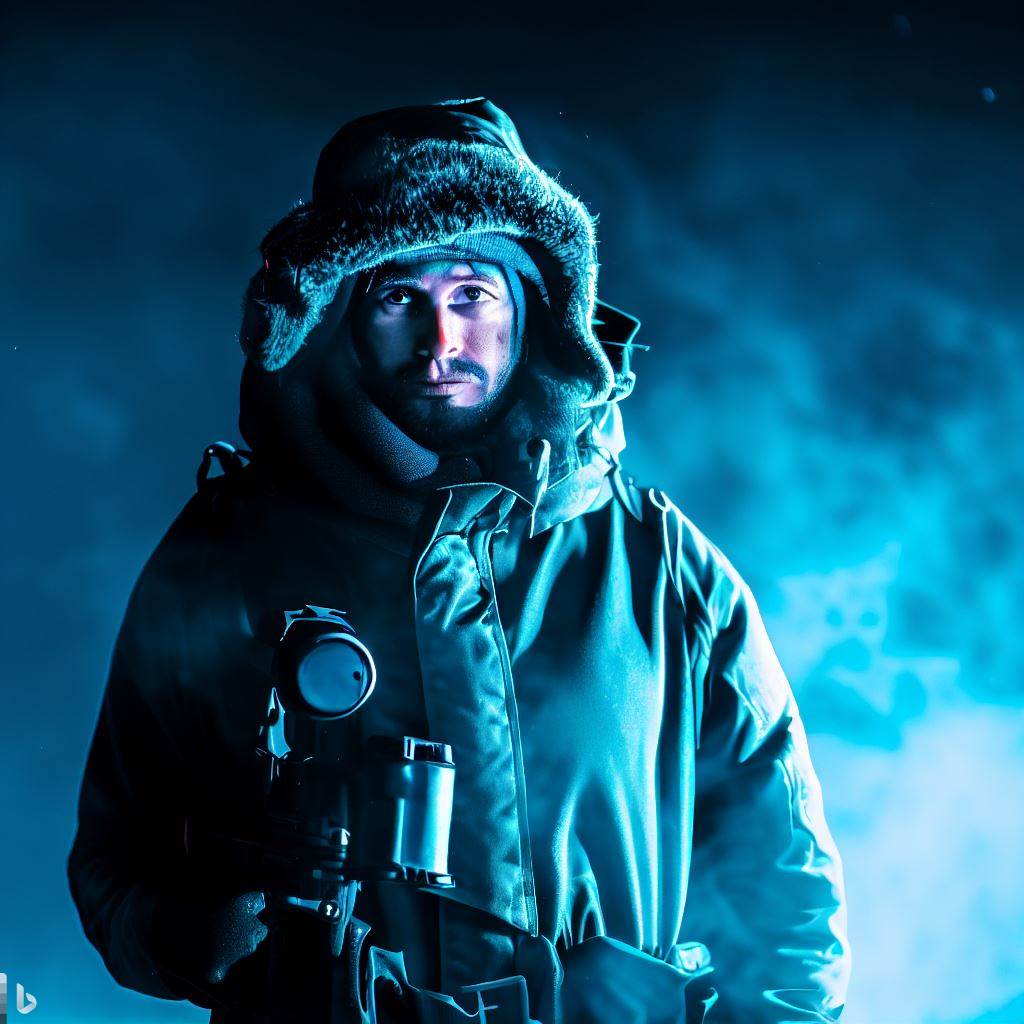

If you’re wondering whether night vision equipment can be used in cold weather, the answer is yes! Cold temperatures usually do not affect the performance of night vision devices, making them a reliable tool even in freezing conditions.
Whether you’re a hunter, a nature observer, or a security professional, night vision equipment can help you see clearly in the dark, regardless of the temperature outside. So, bundle up and embrace the chilly nights while still being able to navigate with ease through the unique capabilities of night vision technology. Yes, you can use night vision equipment in cold weather.
However, it is important to understand the factors that can affect its performance and choose the right equipment for such conditions. In this article, we will explore the various factors affecting night vision performance in cold weather, discuss how to choose the right night vision equipment for these conditions, provide tips for using night vision equipment in cold weather, and address common myths about night vision performance in such conditions.
We will also touch upon cold weather testing and certification standards, discuss the real-world applications of night vision in cold weather, compare night vision with thermal imaging, and highlight the latest technological advancements in night vision for cold weather.
Factors Affecting Night Vision Performance in Cold Weather
Temperature
Temperature plays a crucial role in the performance of night vision equipment. Cold temperatures can affect the batteries, image intensifier tubes, and overall functionality of the device. Therefore, it is important to choose night vision equipment that can withstand low temperatures and still provide optimal performance.
Battery Life
In cold weather conditions, batteries tend to drain faster than normal. This is due to the decrease in chemical reactions within the battery, leading to reduced power output. It is essential to consider the battery life of the night vision equipment and choose one that can withstand extended use in cold weather conditions.
Fogging and Condensation
Fogging and condensation can hinder the performance of night vision equipment in cold weather. When the lenses and eyepiece of the device come into contact with the cold air, moisture can accumulate, causing fogging and obstructing the view. Night vision equipment with proper fog-resistance and anti-fogging solutions can help mitigate this issue.
Performance of Image Intensifier Tubes
Image intensifier tubes are a key component of night vision equipment. These tubes amplify the available ambient light to create a visible image. In cold weather, the performance of these tubes can be affected. It is important to choose night vision equipment with high-quality image intensifier tubes that can maintain their performance even in low temperatures.
Choosing The Right Night Vision Equipment for Cold Weather
Temperature Range
When selecting night vision equipment for cold weather, it is crucial to consider the temperature range it can withstand. Some devices are specifically designed for extreme cold temperatures, while others may only be suitable for milder cold weather conditions. Ensure that the temperature range of the equipment aligns with the environmental conditions you will be using.
Battery Type And Capacity
Given the colder temperatures, it is essential to choose night vision equipment with batteries that are capable of performing well in such conditions. Lithium batteries are known to perform better in cold weather compared to alkaline batteries. Additionally, considering the battery capacity is important to ensure extended operation without frequent battery changes.
Waterproofing And Fog Resistance
To protect your night vision equipment from moisture and fog in cold weather, look for devices that are waterproof and have proper fog resistance features. This will help prevent damage to the internal components and maintain clear visibility even in challenging weather conditions.
Image Intensifier Tube Quality
The quality of the image intensifier tube directly affects the performance of night vision equipment. In cold weather, it is crucial to have high-quality tubes that can maintain their performance and provide clear imagery. Look for equipment that uses advanced image intensifier tube technology for optimal performance in low temperatures.
Ergonomics And Ease Of Use
In cold weather conditions, it is important to have night vision equipment that is ergonomically designed and easy to handle with gloves on. Consider factors such as button placement, user interface, and overall comfort when choosing equipment for cold weather use.
Tips For Using Night Vision Equipment In Cold Weather
Keep Equipment Warm
To ensure optimal performance, it is advisable to keep your night vision equipment warm when not in use. Extreme cold can affect the battery life and functionality of the device. Carrying the equipment close to your body or using insulating covers can help keep it warm.
Protect The Eyepiece
The eyepiece is a delicate component that can be easily damaged in cold weather. Protect it from impacts and ensure it is properly covered when not in use. This will prevent any damage and maintain the clarity of your view.
Anti-Fogging Solutions
Using anti-fogging solutions on the lenses and eyepiece can help prevent fogging and condensation in cold weather conditions. These solutions create a protective barrier that repels moisture and ensures a clear view.
Avoid Rapid Temperature Changes
Rapid temperature changes can cause thermal shock and damage the internal components of night vision equipment. Avoid exposing the device to extreme temperature fluctuations. If you need to move from a warm environment to a cold one, allow the equipment to acclimate gradually before use.
Carry Spare Batteries
In cold weather, batteries tend to drain faster. Always carry spare batteries to ensure uninterrupted operation of your night vision equipment. Keep the spare batteries in a warm pocket to maintain their performance.
Cover Exposed Parts
Sometimes, night vision equipment may have exposed parts, such as antennae or buttons. In cold weather, cover these parts with protective caps or insulating materials to prevent damage and maintain the usability of the device.
Preventative Maintenance And Care
Regular Cleaning
Regular cleaning is crucial to maintain the performance of your night vision equipment in cold weather. Remove any dirt, debris, or moisture, and ensure that the lenses and eyepiece are clean and free from obstructions. Follow the manufacturer’s instructions for proper cleaning techniques and use appropriate cleaning tools and solutions.
Checking For Damage
Regularly inspect your night vision equipment for any signs of damage or wear. Cold weather conditions can exacerbate existing issues, so it is important to address any damages promptly. Check for loose connections, cracks, or any other visible signs of damage that might affect the functionality of the device.
Storing In Proper Conditions
When not in use, store your night vision equipment in a cool, dry place. Avoid exposing it to extreme temperatures or moisture. Proper storage conditions will help prolong the lifespan of the device and ensure its optimal functionality in cold weather.
Common Myths About Night Vision Performance In Cold Weather
Myth 1: Night Vision Doesn’t Work In Extreme Cold
Contrary to this myth, modern night vision equipment is designed to operate in extreme cold temperatures. However, it is important to choose equipment that is specifically certified and tested for such conditions.
Myth 2: Night Vision Drains Batteries Quickly In Cold Weather
While it is true that batteries tend to drain faster in cold weather, quality night vision equipment is designed to optimize battery performance even in low temperatures. Choosing equipment with efficient power management systems and using high-quality batteries can help mitigate this issue.
Myth 3: Cold Weather Damages Night Vision Equipment
Cold weather itself does not necessarily damage night vision equipment. However, exposure to moisture, extreme temperature fluctuations, and mishandling can cause damage. By following proper care and maintenance practices, you can ensure the longevity and performance of your night vision equipment in cold weather.
Cold Weather Testing And Certification Standards
MIL-STD-810G
MIL-STD-810G is a standard set by the United States Department of Defense that defines environmental testing methods for various equipment, including night vision equipment. This standard ensures that the equipment can withstand harsh conditions, including cold weather, and still provide the expected performance.
IP Ratings
IP (Ingress Protection) ratings are used to indicate the level of protection provided by a device against dust and moisture. Night vision equipment with higher IP ratings offers better protection against cold weather conditions, preventing damage due to moisture and ensuring optimal functionality.
Real-World Applications Of Night Vision In Cold Weather
Military And Law Enforcement Operations
Night vision equipment is extensively used by military and law enforcement agencies in cold weather conditions. From reconnaissance missions to surveillance, the ability to see clearly in the dark provides a tactical advantage in challenging environments.
Hunting And Outdoor Activities
Night vision equipment is also popular among hunters and outdoor enthusiasts who engage in activities during the nighttime in cold weather. It allows them to observe wildlife, track game, and navigate safely in low-light conditions.
Search And Rescue Missions
In cold weather, search and rescue missions can be challenging due to limited visibility. Night vision equipment proves invaluable in such situations, enabling rescuers to locate individuals in need of help and navigate through difficult terrain.
Comparing Night Vision With Thermal Imaging in Cold Weather


Technology Differences
Night vision and thermal imaging are two separate technologies used for low-light and nighttime visibility. Night vision relies on amplifying ambient light, whereas thermal imaging detects the heat signatures emitted by objects. Both technologies have their advantages and disadvantages in cold weather conditions.
Pros And Cons
Night vision equipment provides better detail and recognition capabilities in low-light conditions, making it effective for identifying objects and individuals. However, it relies on external light sources and can be affected by fogging.
On the other hand, thermal imaging does not require ambient light and can detect hidden objects or individuals based on their heat signatures. However, it may struggle to provide fine details and recognition.
Latest Technological Advancements In Night Vision For Cold Weather


Improved Image Intensifier Tubes
Advancements in image intensifier tube technology have led to improved night vision performance in cold weather. Newer tubes offer better resolution, reduced image distortion, and enhanced low-light sensitivity, resulting in clearer imagery even in challenging conditions.
Thermal Fusion Technology
Thermal fusion technology combines thermal imaging and night vision capabilities into a single device. It overlays thermal images onto the night vision view, providing enhanced situational awareness and improved target detection in cold weather conditions.
Smart Features And Connectivity
Modern night vision equipment often comes with smart features and connectivity options. These include wireless connectivity for data transfer, GPS integration, and compatibility with smartphone applications. These advancements improve the functionality and usability of night vision equipment in cold weather.
Conclusion
In conclusion, using night vision equipment in cold weather is possible with the right equipment and proper care. Factors such as temperature, battery life, fogging, and image intensifier tube performance can affect the performance of night vision equipment in cold weather.
By choosing the right equipment, following best practices, and debunking common myths, you can optimize the performance of night vision equipment in cold weather conditions.
The real-world applications of night vision in cold weather are vast, ranging from military and law enforcement operations to hunting and outdoor activities.
It is important to understand the differences between night vision and thermal imaging, as well as the latest technological advancements in night vision equipment for cold weather.
With the right knowledge and equipment, you can fully utilize the benefits of night vision in cold weather conditions.
Top Night Vision Goggles of 2023: Expert Reviews and Buying Advice
The Ultimate Guide to the Top 5 Night Vision Binoculars for Hunting
Top 5 Night Vision Monoculars for Hunting in 2023 | Best Rating
How Do I Minimize Noise When Using Night Vision For Hunting?





